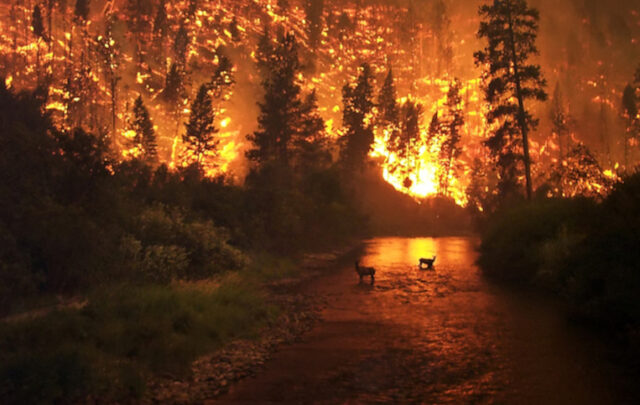From the Saudi Arabian sands pour more than 9 million barrels of crude oil each day, more than 10 percent of the world’s production pumped from what is believed to be the largest pool of recoverable crude on Earth.
For three decades, it has been Saudi Arabian oil that poured into the market to dampen rapidly rising prices and Saudi cutbacks that pushed prices back up when they were abnormally low.
|
Not anymore.
The Saudis say they are still committed to affordable, stable petroleum. But prices have roughly tripled in four years despite periodic Saudi announcements of plans to pump up production.
Control, it seems, has slipped away.
So when the Saudis a few weeks ago suddenly reversed field and announced a production cut, some analysts scratched their heads and wondered if, at long last, Saudi Arabian oil production has peaked. If it has, the effect is potentially huge on oil markets and the price of gasoline at the pump.
“When the price is high, that’s when you want to take out your oil and sell it,” said economist Ujjayant Chakravorty of the University of Central Florida. “I am wondering if they have some production issues.”
In the past, the Saudis have repeatedly passed up the chance to maximize short-term profits. Instead, they have seen high prices as a threat to global economies and an incentive for development of alternative energies that would threaten their cash cow.
When prices have been high, they have pumped more.
“If your concern were energy market stability and not your income level, you’d put more oil out in the market,” said Amy M. Jaffe, energy fellow at Rice University’s Baker Institute. “Why do they see something different now? It doesn’t make sense to me.”
Supply sufficient
More than enough oil is being pumped to satisfy global demand. But when extra pumping power shrinks, threats to supply and geopolitical crises become much more worrisome.
The Saudis explained the recent cuts in production by saying they were just closing the spigot on some extra oil that wasn’t high-quality. They say that they cut back only on what is known as heavy crude — less viscous oil.
Not all refineries can handle that kind of crude, and some refineries that can handle the heavy oil were down for maintenance, the Saudis said.
Possible shrewd move
Most analysts agree that the mismatch — heavy crude in a market that prefers free-flowing light crude — is part of the story. But many are also not convinced that it is the whole story. After all, the Saudis could have sold the heavy crude at a discount, which would tend to push all prices lower.
Some think the Saudis have decided to hold down production because they want more revenue from the oil and they expect prices to rise still more. Oil prices have more than tripled since early 2002, which many in the industry blame on speculation and temporary concern about a few trouble spots.
If the price of oil is going up no matter what, then slowing the pump may be a shrewd move, said economist James Hamilton of the University of California at San Diego. “If we are entering an era of peak oil, then oil is a very valuable commodity, and it makes some economic sense to be saving it to sell at a higher price.”
Skeptics argue that the world is approaching “peak oil,” the halfway point at which a nation’s production crests and then inexorably starts to slip. Some, like controversial author and analyst Matthew Simmons, say the Saudis may have reached that point.
The Saudis agree that at some point, oil production must peak — just not now. Instead, they insist, they will be expanding daily production to 12 million, then 14 million barrels in the next few years.
Record number of rigs
The Saudis say they have a record number of rigs operating, part of their plan to keep production growing. But even the scramble to drill more oil wells sparks doubt.
The Saudis say they are just trying to add spare capacity so they can regain the control over prices that they had for decades. The skeptics wonder whether the search for new oil is just a desperate attempt to compensate for the slow but inexorable slide of production in the massive “king” fields like Ghawar.
Beneath their sand, the Saudis claim proven reserves of 260 billion barrels. Moreover, they expect to discover 200 billion more in the next two decades.
“They are not investing enough to get to 15 million barrels a day,” said Jaffe of Rice University’s Baker Institute. “Don’t tell me the number of rigs they have. I want to know, where are the new fields they are opening and when will they come online?”
How much oil is there to be pumped?
No one truly knows but the senior oil chiefs in Saudi Arabia — and maybe they are not so sure themselves about how much oil still lies beneath the sand. But even if they are right about how much they have, they must take care not to deplete their fields prematurely, since pumping too fast can accelerate the decline of an oil field.
“They want to appear to be helping,” said petroleum geologist Christopher Kendall of the University of South Carolina. “On the other hand, they do not want to destroy their oil fields. They need to husband their resources. They have to find engineering strategies so they don’t lose large parts of their field by overproducing.”
Economist A.F. Alhajji of Ohio Northern University, contributing editor for World Oil magazine, dismissed the idea of peak oil as the echo of an old notion. That’s a fear first broached in 1862 and repeated periodically since, he said.
“We don’t have the right methodology to estimate. It could be that oil already peaked. It could be the peak won’t come for another 200 years.”
War, tension
The recent spike in oil prices may have been spurred by war and geopolitical tension. But behind the climbing price is the fear that oil producers may not be able to make up for any disruption in supplies.
If Saudi Arabia — the nation that had always filled the gap — no longer has the excess capacity to plug holes, then a modest disruption could send prices soaring.
Of course, the higher the price of oil, the more incentive there is to find more of it.
And since oil prices have not been high for all that long, oil analysts say that it is simply too early to see the results of new explorations and methods.
But it is not only about availability. It is also about cost — the costs of extracting it, refining it, delivering it — in addition to the risk factor that has been added to oil prices these past several years.
Oil in Saudi Arabia has always been notoriously inexpensive — costing just a couple dollars a barrel to produce. But the nation’s giant fields have been squeezed for decades. They require ever more complex technology to keep producing.
Even if there is plenty more oil, Saudi Arabia has indeed hit a turning point, Kendall said. “The peak for cheap oil has been reached — absolutely.”
If Saudi production languishes for a month or two, that won’t prove the peak has arrived, Hamilton said. On the other hand, if world demand for oil keeps growing while the pace of Saudi pumps does not, that would show they either won’t or can’t keep up.
“Right now, I am not really sure how to read things beyond concluding that the Saudi statements do not make sense, do not fit the market situation and don’t fit what they are doing,” Hamilton said. “The evidence is going to dribble in.”





